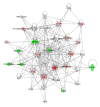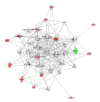Ultraviolet radiation and the slug transcription factor induce proinflammatory and immunomodulatory mediator expression in melanocytes
- PMID: 22745913
- PMCID: PMC3382223
- DOI: 10.1155/2012/410925
Ultraviolet radiation and the slug transcription factor induce proinflammatory and immunomodulatory mediator expression in melanocytes
Abstract
Despite extensive investigation, the precise contribution of the ultraviolet radiation (UVR) component of sunlight to melanoma etiology remains unclear. UVR induces keratinocytes to secrete proinflammatory and immunomodulatory mediators that promote inflammation and skin tumor development; expression of the slug transcription factor in keratinocytes is required for maximal production of these mediators. In the present studies we examined the possibility that UVR-exposed melanocytes also produce proinflammatory mediators and that Slug is important in this process. Microarray studies revealed that both UVR exposure and Slug overexpression altered transcription of a variety of proinflammatory mediators by normal human melanocytes; some of these mediators are also known to stimulate melanocyte growth and migration. There was little overlap in the spectra of cytokines produced by the two stimuli. However IL-20 was similarly induced by both stimuli and the NFκB pathway appeared to be important in both circumstances. Further exploration of UVR-induced and Slug-dependent pathways of cytokine induction in melanocytes may reveal novel targets for melanoma therapy.
Figures



Similar articles
-
Ultraviolet radiation stimulates expression of Snail family transcription factors in keratinocytes.Mol Carcinog. 2007 Apr;46(4):257-68. doi: 10.1002/mc.20257. Mol Carcinog. 2007. PMID: 17295233
-
Ultraviolet exposure of melanoma cells induces fibroblast activation protein-α in fibroblasts: Implications for melanoma invasion.Int J Oncol. 2011 Jul;39(1):193-202. doi: 10.3892/ijo.2011.1002. Epub 2011 Apr 13. Int J Oncol. 2011. PMID: 21491083
-
Ultraviolet radiation directly induces pigment production by cultured human melanocytes.J Cell Physiol. 1987 Oct;133(1):88-94. doi: 10.1002/jcp.1041330111. J Cell Physiol. 1987. PMID: 2822734
-
Inflammasome activation of IL-1 family mediators in response to cutaneous photodamage.Photochem Photobiol. 2012 Sep-Oct;88(5):1111-25. doi: 10.1111/j.1751-1097.2012.01182.x. Epub 2012 Jul 9. Photochem Photobiol. 2012. PMID: 22631445 Free PMC article. Review.
-
Involvement of cytokines, DNA damage, and reactive oxygen intermediates in ultraviolet radiation-induced modulation of intercellular adhesion molecule-1 expression.J Invest Dermatol. 1995 Jul;105(1 Suppl):67S-70S. doi: 10.1111/1523-1747.ep12316095. J Invest Dermatol. 1995. PMID: 7616000 Review.
Cited by
-
Melanogenic Difference Consideration in Ethnic Skin Type: A Balance Approach Between Skin Brightening Applications and Beneficial Sun Exposure.Clin Cosmet Investig Dermatol. 2020 Mar 9;13:215-232. doi: 10.2147/CCID.S245043. eCollection 2020. Clin Cosmet Investig Dermatol. 2020. PMID: 32210602 Free PMC article. Review.
-
Slug, a Cancer-Related Transcription Factor, is Involved in Vascular Smooth Muscle Cell Transdifferentiation Induced by Platelet-Derived Growth Factor-BB During Atherosclerosis.J Am Heart Assoc. 2020 Jan 21;9(2):e014276. doi: 10.1161/JAHA.119.014276. Epub 2020 Jan 21. J Am Heart Assoc. 2020. PMID: 31959031 Free PMC article.
-
Trends in Regenerative Medicine: Repigmentation in Vitiligo Through Melanocyte Stem Cell Mobilization.Med Res Rev. 2017 Jul;37(4):907-935. doi: 10.1002/med.21426. Epub 2016 Dec 28. Med Res Rev. 2017. PMID: 28029168 Free PMC article. Review.
References
-
- Leiter U, Garbe C. Epidemiology of melanoma and nonmelanoma skin cancer—the role of sunlight. Advances in Experimental Medicine and Biology. 2008;624:89–103. - PubMed
-
- Jhappan C, Noonan FP, Merlino G. Ultraviolet radiation and cutaneous malignant melanoma. Oncogene. 2003;22(20):3099–3112. - PubMed
-
- Moan J, Porojnicu AC, Dahlback A. Ultraviolet radiation and malignant melanoma. Advances in Experimental Medicine and Biology. 2008;624:104–116. - PubMed
-
- Kanavy HE, Gerstenblith MR. Ultraviolet radiation and melanoma. Seminars in Cutananeous Medicine and Surgery. 2011;30(4):222–228. - PubMed
-
- Hocker T, Tsao H. Ultraviolet radiation and melanoma: a systematic review and analysis of reported sequence variants. Human Mutation. 2007;28(6):578–588. - PubMed
Grants and funding
LinkOut - more resources
Full Text Sources
Research Materials

